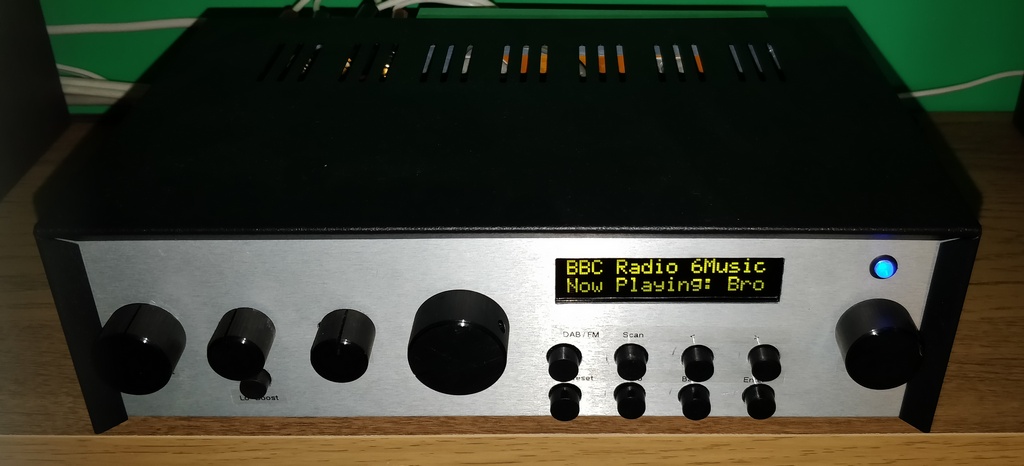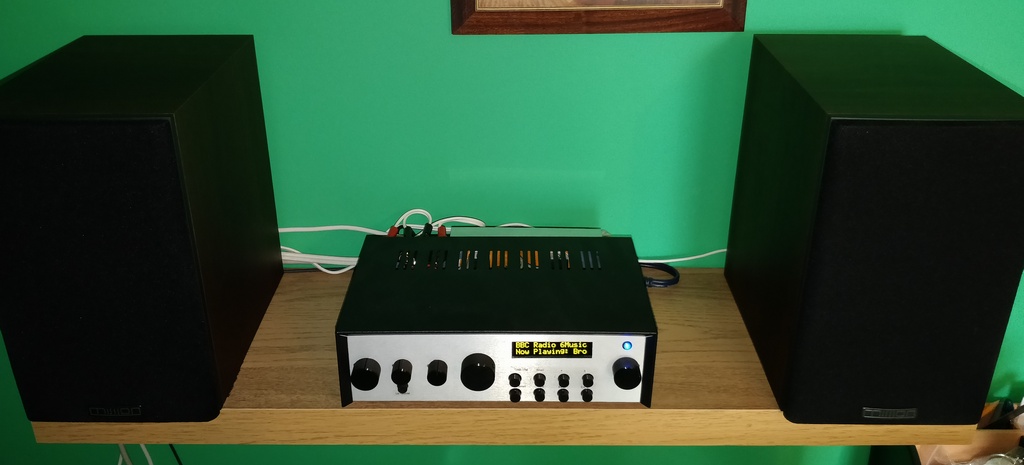DAB Digital Radio LM3886 Amplifier - Introduction
1 - Intro, 2 - Investigation, 3 - Design, 4 - PSU and Amp, 5 - Control Board, 6 - Software, 7 - Summary
The short description
Hi! Here you can read about my DAB radio amplifier, and how I turned this:
into this:


This is a semi custom build, where I extracted the DAB tuner module from an old (and very cheap) DAB radio, but wrapped it with my own build of the amplifier, buttons, LCD display and so on.
Prior to the build, I was using my own amplifier with a Pure Tempus 1 XT DAB radio as the source. I also had a cheap DAB radio, a Bush CDAB85R which I bought second hand for less than a fiver.
I was initially disappointed that the radio was mono only, even when using the headphone output, which was a stereo socket, but output a mono signal only.
With my Tempus DAB radio regularly failing, and no obvious repair, I started to investigate this Bush DAB radio further.
In these pages, you'll find information about how I reversed engineered how the DAB module interfaces with it's LCD and other circuitry, and what I used to bring this module up to my standard, including:
- An LM3886 68W Class AB Amplifier - also known as the Gainclone
- A preamp with analogue volume control, bass, treble and bass boost button
- MCOB21605G1V-EYP Midas OLED display (like LCD, but much clearer
- PIC16F77 - An old microcontroller rescued from my original University project in 2005
- Linear power supplies
Why DAB?
There are many criticisms about DAB. It's based on old digital technology (mp2, i.e. before even mp3) and some say that old fashioned FM has better quality.
Some of the criticism is fair - in the UK, we haven't evolved to DAB+, which is slightly better. We also have quite a few radio stations crammed into the DAB spectrum, which means some of these are mono, rather than stereo, and the best bit-rate is 128kpbs, with many stations around 80kbps.
I'm sure that with a very good aerial, and receiver, FM could be better quality, but I rarely encounter that. DAB to me seems to handle interference better (until a point, then it falls away quite a lot).
The main reason though is my favourite radio station, BBC Radio 6 Music, is only on DAB or online. I've been listening to 6 music since 2004 when I discovered it through a recommendation from the Indie society at my university. Shamelessly addicted ever since and whenever I'm working from home, the radio is on, hence why I wanted to build myself a really nice one.
Of course listening online is another option of similar quality, but this relies on the internet connection working well, and whilst I used the Chromecast Audio for a while between the total failure of my Pure Tempus, and the completion of this build, I found sometimes it would just stop for no reason.
The other nice reason is the text display DAB gives, which can display what tune is playing amongst other information.
The build plan
The plan was to build something nice, obviously, but also keep it cheap and use as many existing components as I could from my collection.
The radio would include a DAB tuner from an existing system, which also gives me FM. I'd also have an additional three other inputs to allow me to connect my Chromecast for streaming other audio (such as radio catch up services, or mp3s via my Plex server), a desktop PC, and one spare input.
I raided my collection of parts to see what I had and wanted to use:
- I had an ESP Project 19 (revision A) power amplifier that came out of my 5.1 amp during the rebuild. This including two existing LM3886 chips
- I also built a power supply PCB which I intended to use with my main amp but never did. It has six 4,700 &µF 63V capacitors on it, and the diodes, resistor and capacitor necessary for an earth loop breaker
- I had an old toroidal transformer I brought cheap around 2005, which is dated even older - 1995. It's rated 120VA with 2x18V AC outputs.
- I had a number of parts I brought during the closing down of Maplin - an OLED display (HD44780 compatible), a number of potentiometers, some switches, blue LEDs etc.
I had a PIC16F77 from my original university project from 2005 sitting unused which I could reprogram and use for this build, if I needed to
I wanted to build the system into a case no bigger than my original TDA2030 amplifier that I was using previously - that's a 10 inch (25 cm) wide case.
Read on...
You can find more details of the build, on these pages:
